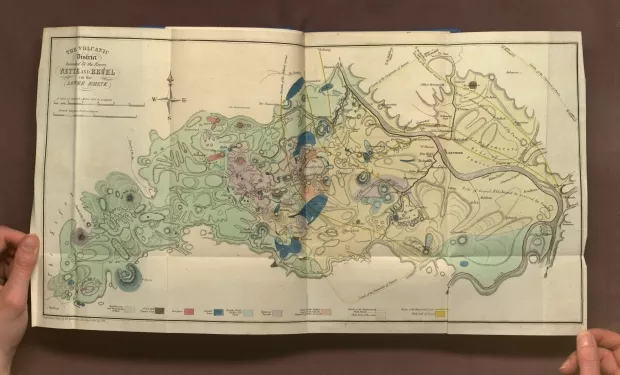Creation Date
1832
Height
28 cm
Width
52 cm
Medium
Genre
Description
This topographical portrayal of the Eifel mountain range suggests that Romantic culture was developing a more scientific interest in volcanism. The image evokes neither the sublime nor the picturesque, yet the book it illustrates—a scientific work concerning the origins of volcanoes—sells very successfully. Depicting roughly 35 miles of the Eifel mountain range, this topographic map is color coded to indicate rock type. Volcanoes are depicted by sets of lines, each which culminates in a circle to indicate the crater. Also depicted are small towns, landmarks, and rivers. In the center of the image, Laacher See is shown with numerous, ring-like shapes in and around the water-filled crater. The key, showing which colors represent which rocks, is found along the lower portion of the map, while the compass rose is in the upper left.
For his accurate surveys of the Shetland Islands (in which he found vast iron deposits), the Society of Arts awarded Samuel Hibbert with the Iris Gold Metal. During the early 1820s, Samuel Hibbert-Ware’s reputation as a geologist increased significantly due to this prestigious award. The sell of his book (Survey of the Shetland Islands) financially enabled him to focus on surveying land, and he later performed a survey of Laacher See (D. Hudson, The Royal Society of Arts 84).
This topographical portrayal of the Eifel mountain range suggests that Romantic culture was developing a more scientific interest in volcanism. The image evokes neither the sublime nor the picturesque, yet the book it illustrates—a scientific work concerning the origins of volcanoes—sells very successfully.
"The Volcanic District" was engraved for the book History of the Extinct Volcanoes in 1831 shortly after Charlotte and Samuel Hibbert-Ware surveyed the lands surrounding Laacher See. A copy of their topographic map is now owned and available to the public in Memorial Library at the University of Wisconsin—Madison.
Locations Description
Laacher See
This supervolcano in western Germany is characterized by the enormous magma chamber beneath its crater. The chamber is so large that if it were to erupt, the size of the blast would be thousands of times larger than that of Mount Vesuvius’ eruption in 79 AD. Such an eruption would wipe out European civilization, and would perhaps bring about a new ice age by blocking the sun's light with ash. When the Hibbert-Wares surveyed the land around Laacher See, they could not completely understand what they were mapping—Samuel Hibbert-Ware only theorized that Laacher See was a volcano. Even today, the Laacher See has been so little researched that scientists cannot predict if the volcano will erupt tomorrow or millennia from now. Charlotte and Samuel Hibbert-Ware were pioneers in research concerning Laacher See and supervolcanoes in general (B. Scharf and S. Bjork, Eifel Maar Lakes 52-73).
Eifel Mountain Range
This large mountain range, running through western Germany and parts of Belgium and Luxemburg, contains many volcanoes, including Laacher See (B. Scharf and S. Bjork, Eifel Maar Lakes 12).
Shetland Islands
This archipelago off the northern coast of Scotland was the subject of numerous studies by Samuel Hibbert-Ware; most significantly, he found vast amounts of iron on the islands. His surveys of these islands gave him the skills and prestige necessary to study Laacher See later in life. Today the islands form the border of the North Sea and the Atlantic Ocean (H. Haswell-Smith, The Scottish Islands 211).
Copyright
Copyright 2009, Memorial Library, University of Wisconsin, Madison
Publisher
W. and D. Laing
Collection
Accession Number
A10966
Additional Information
Bibliography
Benezit, Emmanuel. Dictionary of Artists. Paris: Grund, 2006.
Breining, Greg. Supervolcano: The Ticking Time Bomb. St. Paul, MN: Voyageur P, 2007.
Evans, Joan. A History of the Society of Antiquaries. London: Oxford UP, 1956.
Haswell-Smith, Hamish. The Scottish Islands. Edinburgh: Canongate, 2004.
Hudson, Derek. The Royal Society of Arts, 1754-1954. London: Murray, 1954.
Mayer, Ralph. HarperCollins Dictionary of Art Terms and Techniques. New York, N.Y: Harper Perennial, 1991.
Scharf, Burkhard W., and Sven Björk, eds. Limnology of Eifel Maar Lakes. Stuttgart: E. Schweitzerbart’sche Verlagsbuchhandlung, 1992.
Sutton, C. W. “Ware, Samuel Hibbert- (1782–1848).” Oxford Dictionary of National Biography.Ed. H. C. G. Matthew and Brian Harrison. Oxford: OUP, 2004. 2 Apr. 2009 http://www.oxforddnb.com/view/article/13197.

